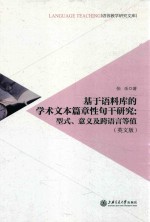

基于语料库的学术文本篇章性句干研究 型式、意义及跨语言等值PDF电子书下载
- 电子书积分:11 积分如何计算积分?
- 作 者:张乐著
- 出 版 社:上海:上海交通大学出版社
- 出版年份:2015
- ISBN:9787313139245
- 页数:265 页
Chapter 1 Introduction 1
1.1 Research Background 1
1.2 Objectives of this Book 4
1.3 Significance of this Book 5
1.4 Organization 6
Chapter 2 Literature Review 8
2.1 Pawley&Syder's Lexicalized Sentence Stem 8
2.2 Granger&Paquot's Textual Stentence Stem 12
2.3 Textual Stentence Stem and Evaluation 14
2.3.1 The Multifunctionality of TSSs 14
2.3.2 Research on Evaluation in Academic Writing 17
2.3.2.1 Hedging 18
2.3.2.2 Metadiscourse 20
2.3.2.3 Model of Interaction in Academic Discourse 23
2.3.3 Evaluation from a Cross-cultural Perspective 25
2.4 Corpus-driven Studies of Phraseology 28
2.4.1 The Firthian Tradition 29
2.4.2 Lexis and Grammar 30
2.4.3 Idiom Principle 31
2.4.4 Extended Unit of Meaning 33
2.4.5 Pattern Grammar:a New Approach to the Lexical Grammar 35
2.4.6 Corpus-driven Study of Cross-linguistic Equivalence 39
2.5 Summary 46
Chapter 3 Methodological Considerations 48
3.1 Research Questions 48
3.2 Corpora Used in this Book 49
3.2.1 The English Comparable Corpus:JDEST 49
3.2.2 The Chinese Comparable Corpus:MCC 51
3.2.3 The Parallel Corpus:JDPC 52
3.3 Analytical Concepts and Procedures 56
3.3.1 Defining TSS,Pattern and Lexical Sequence 56
3.3.2 Searching for TSSs 60
3.3.2.1 Cluster and N-gram 60
3.3.2.2 Phrase Frame 62
3.3.3 Describing Evaluation 65
3.3.4 Looking for Translations 69
3.3.5 Identifying Equivalents 70
3.3.6 Other Terminological Issues 71
3.4 Summary 72
Chapter 4 Overall Frequency Distribution of TSSs 73
4.1 Overall Frequency Distribution of TSSs across Patterns 73
4.2 Content Subject Patterns 75
4.3 Dummy Subject Patterns 79
4.4 Stability and Variability of TSSs 85
4.5 Summary 90
Chapter 5 Functional Characteristics of TSSs 91
5.1 Functional Taxonomy of TSSs 91
5.2 Cognitive Acts 94
5.3 Research Acts 104
5.4 Inference Acts 111
5.5 Attitude Marking 119
5.6 Hedging 126
5.7 Directive Acts 130
5.8 Intertextual Acts 135
5.8.1 Averral and Attribution 135
5.8.2 Categories of Intertextual Acts 136
5.8.3 TSS of Agentative Integral Citation 138
5.8.3.1 Tense of Reporting Verbs and Evaluation 138
5.8.3.2 A Special Case:the Unspecified Author 140
5.8.3.3 Two Layers of Evaluation in Attribution 143
5.8.4 TSSs of Non-agentative Integral Citation 151
5.8.5 TSSs of Identifying Non-integral Citation 152
5.8.6 TSSs of Non-identifying Non-integral Citation 156
5.9 Intratextual Acts 160
5.10 Discussion:Strategic Balancing in Academic Writing 162
5.11 Summary 169
Chapter 6 Cross-linguistic Equivalence of TSSs in English and Chinese 170
6.1 Preliminaries 170
6.2 Content Subject TSSs and Chinese Equivalents 173
6.2.1 pro v that 173
6.2.2 pro modal v that 175
6.2.3 n v that 178
6.2.4 n v-link that 181
6.3 Dummy Subject TSSs and Chinese Equivalents 183
6.3.1 Sentence-medial Chinese Equivalents 184
6.3.2 Sentence-initial Chinese Equivalents 189
6.3.2.1 it v-link v-ed that 189
6.3.2.2 it v-link adj that 193
6.3.2.3 it v-link adj to v that and it modal be v-ed that 195
6.3.3 Sentence-final Chinese Equivalents 196
6.4 Translation Units and Equivalence 201
6.4.1 Equivalence of Lexical Sequences 202
6.4.2 Equivalence of Patterns 202
6.4.3 Equivalence of TSSs 205
6.4.4 Equivalence of Phrases around a Node Word 208
6.5 Contextualizing Description and Translation 215
6.5.1 Levels of Context and Co-selection 215
6.5.2 Identifying Functions and Equivalence in Context 218
6.6 Cross-linguistic Equivalence:Possible New Light 231
6.6.1 New Light on ESP Teaching and Learning 231
6.6.2 New Light on Contrastive Lexical Studies 234
6.6.3 New Light on Lexicon Construction 234
6.7 Summary 236
Chapter 7 Conclusion 238
7.1 Major Findings 238
7.2 Implications 244
7.3 Limitations 247
References 249
Index 261
- 《思维的囚徒 活出生命的意义7原则》赵晓瑞译;(美)亚历克斯·佩塔克斯 2019
- 《医患会话中医生诊疗话语的个体化意义建构研究》梁海英著 2019
- 《中国学术思想研究辑刊 二十编 第9册 欧阳修《诗本义》研究新探 重估汉宋《诗经》学的转变与意义 上》陈战峰著 2015
- 《论中国文化的世界性意义:全国高校国际汉学(中国学)学术研讨会论文集》张西平 2018
- 《语料库驱动的短语配价型式研究》甄凤超著 2019
- 《库萨哲学及其历史意义研究=A STUDY ON NICHOLAS OF CUSAS PHILOSOPHY AND ITS HISTORICAL SIGNIFICANCE》李华著 2020
- 《大图景 论生命的起源、意义和宇宙本身》(美)肖恩·卡罗尔(Sean Carroll)著 2019
- 《认知符号学 自然、文化与意义的现象学路径=COGNITIVE SEMIOTICS:A PHENOMENOLOGICAL APPROACH TO NATURE》CULTURE (瑞典
- 《中国道路及其本源意义》韩庆祥著 2019
- 《生命有何意义 培根的人生哲学》(英)培根著 2020
- 《中风偏瘫 脑萎缩 痴呆 最新治疗原则与方法》孙作东著 2004
- 《水面舰艇编队作战运筹分析》谭安胜著 2009
- 《王蒙文集 新版 35 评点《红楼梦》 上》王蒙著 2020
- 《TED说话的力量 世界优秀演讲者的口才秘诀》(坦桑)阿卡什·P.卡里亚著 2019
- 《燕堂夜话》蒋忠和著 2019
- 《经久》静水边著 2019
- 《魔法销售台词》(美)埃尔默·惠勒著 2019
- 《微表情密码》(波)卡西亚·韦佐夫斯基,(波)帕特里克·韦佐夫斯基著 2019
- 《看书琐记与作文秘诀》鲁迅著 2019
- 《酒国》莫言著 2019
